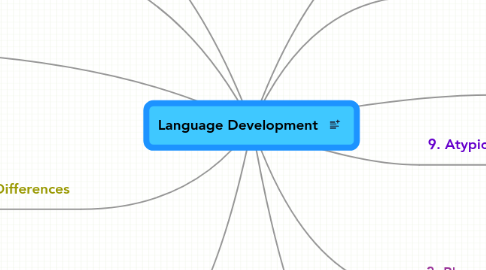Language Development
by Dan Taylor


1. 1. Overview
1.1. Course
1.2. Biological Bases
1.3. Structure
1.4. Study
2. 7. Theoretical Approaches
2.1. Distinguishing Features
2.2. Behavioural
2.3. Linguistic
2.4. Interactionist
3. 11. Adults
3.1. Social Groups
3.2. Work
3.3. L2 Acquisition
3.4. Adult Registers
3.5. Advanced Age
3.6. Brain Damage
4. 8. Individual Differences
4.1. Research History
4.2. Early Words
4.3. Speech Stream
4.3.1. Segmenting
4.4. Early Sentences
4.5. Stability
4.6. Sources
4.7. Context
4.7.1. Child
4.7.2. Care-giver
4.7.3. Language
4.8. Implications
4.8.1. L Acquisition
5. 4. Semantics
5.1. Relationship
5.1.1. Words
5.1.2. Referents
5.2. Theory
5.3. Early Words
5.4. Adult Speech
5.4.1. Influence
5.5. Later Development
5.6. Metalinguistic Development
6. 2. Infants
6.1. Pre-Speech
6.1.1. Communicative Intent
6.1.2. Social Context
7. 5. Preschoolers
7.1. Morphology
7.1.1. Development
7.2. Syntax
7.2.1. Nature
7.2.2. Development
7.2.3. Measuring
7.2.4. 2-Word Utterances
7.2.5. Sentence Modalities
7.3. Later Developments
7.4. Beyond Preschool
8. 6. Preschool
8.1. Communicative Competence
8.2. Social Context
9. 9. Atypical Development
9.1. Hearing Impairment
9.2. Mental Retardation (sic)
9.3. ASD
9.4. PDD
9.5. Specific Language Impairment
10. 3. Phonology
10.1. English
10.2. Infant Speech Perception
10.3. Production
10.3.1. Pre-Linguistic
10.3.2. Protowords
